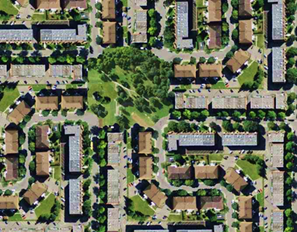
Since the pandemic unfolded, one of the most-used keywords for the way we live is flexibility.
Now, towns across the United States are asking if the old, rigid approach to zoning meets our evolving needs.
Take Seattle. There, the City Council has just decided to let condo and rental towers replace a string of struggling retail buildings along Third Avenue. The goal? Residential high-rises over storefronts. Taller towers (up to 440 feet — more than double Seattle’s prior height limit) will soon be allowed, as part of a downtown revitalization effort.
Councilmember Andrew Lewis summed things up: “Downtowns have to evolve.” The entire council agreed — though some still opposed this particular change, believing that it doesn’t go far enough in creating affordable units for the city’s downtown core.
That said, Seattle’s point is made. Struggling commercial downtowns are fair game to convert — at least partially — into residential zoning.
“Upzoning”: An Idea Whose Time Has Come?
Since the pandemic started, there’s been a huge shift in cities and towns. Commercial buildings are less in demand. Meanwhile, there’s a pressing need to give people more residential offerings.
One idea that can work well in many places is endearingly called “upzoning” (because it sounds a little better than “higher density”). The idea is all about adding more housing or encouraging a blend of types of properties in a certain area, by making changes to the zoning. Declining commercial areas can allow for residential units and draw new interest. Areas that used to only allow single-unit homes can be updated so that a homeowner can build accessory housing units on a property.
Those curious about whether they may build an accessory dwelling unit can look up accessory dwelling rules for specific towns at AccessoryDwellings.org: What Are the Rules Where I Live? Modified zoning is a helpful trend that’s gaining traction all over the country.
Government and university research, noted by JPMorgan.com, showed that upzoning “can substantially increase output per worker, increase mean wages and decrease commuting times (particularly for people forced to live far from where the jobs are due to the cost of real estate).”
The research additionally indicated that upzoning can be far more impactful than only adding to road and public transportation infrastructure.
Lessons From a Backlash in Connecticut
But recently, the Planning and Zoning Commission of Norwalk, Connecticut went in the reverse direction. It added a zone exclusively for single-unit houses with large lots in 2023.
Norwalk’s original plan would have been all about adding a greater allowance for density in certain single-unit residential zones. But there was a revolt in the upscale area against that concept. Some residents came together to create anti-upzoning groups on social media. After residents expressed their opinions, reports Norwalk’s newspaper, The Hour, “the upzoning of almost all single-family neighborhoods was scaled back.”
Could the town of Norwalk have succeeded in their upzoning goals if they had done more publicizing of what they wanted? If they had worked harder for the population’s buy-in? Maybe so. At least, they needed to be ready to answer residents’ concerns about parking and overall congestion. Perhaps they needed (and still need) to couple upzoning with efforts to create attractive public transit.
There are always lessons to learn, and new questions to ask, when a plan doesn’t come together as hoped.
Upzoning Means More Transactions
Zoning laws can affect many aspects of a town. It can impact property valuations, and it can encourage more transactions. In some cases, that means more deeds going into circulation. And it means deeds may be subject to new sets of allowances and limits.
Residential developers, agents, and people concerned about suburban sprawl usually support such shifts. Builders generally like multi-unit property allowances because they allow for more sales, and attract bigger pools of interested buyers. Builders get to make more units in a given project. (And this means they can more easily set aside percentages of projects for affordable housing, which might be required by law.)
Given the way U.S. sale and rental prices have outpaced wages, upzoning can be a uniquely helpful method of getting roofs over heads at all. Oregon is a national upzoning leader.
In contrast, many residential areas across the country are zoned for big lots with single units. Building affordable, multi-unit homes on a property is not allowed in those areas. Some hear plans for upzoning and rebel against it. Norwalk, Connecticut isn’t the only town that’s walking back its aspirations for upzoning.
Can “Upzoning” Override Deed Language?

Homes that are subject to homeowner associations, or homes that simply carry anti-subdivision language, might be barred from creating multiple units on their parcels of land.
Now, what happens if the homeowner’s deed restricts the property to a single residential unit, but suddenly the neighborhood is upzoned? The answer is in the local laws.
Take Austin, Texas, for example. The city says a private deed restriction takes precedent. So the homeowner won’t be able to add an extra unit to take advantage of the zoning change.
And here’s Concord Township, in Lake County, Ohio, saying the deed language wins:
A deed restriction that is enforceable now should continue to be enforceable, regardless of changes to zoning regulations. Zoning does not extinguish the obligations between parties to a deed restriction.
To Achieve Policy Goals, Will Some Governments Push Private Restrictions Aside?
Sure. At least, some will try. California has attempted to impose upzoning in places where it would trump private deed restrictions.
When states or cities deliberately clash with private property restrictions, the parties with the most at stake tend to see each other in court. There, the private deed restrictions might be upheld. Or courts could go the other way, and stick up for public zoning modifications. Creating more housing in a time of an affordability crisis could be a compelling public policy matter that a court wants to respect.
And so the struggle continues.
Important note to our readers: The discussions available at Deeds.com are intended to explore important issues related to deeds and real estate transactions. They do not constitute financial legal advice. Meet with a lawyer or finance professional to obtain case-specific guidance.
Supporting References
Heidi Groover for the Seattle Times: Real Estate Seattle OKs Zoning Changes, Hoping to Attract More Downtown Housing (Sep. 26, 2023).
Katherine Lutge for the Norwalk Hour (a part of Hearst Media Services Connecticut, LLC): Norwalk Adds New Single-Family Zone to Draft Zoning Rewrite (Oct. 13, 2023). Also by Katherine Lutge in the Norwalk Hour: As Norwalk Grows, Residents Say Parking Congestion Has Made Streets Impassable and Like the “Wild, Wild West“ (Oct. 5, 2023).
Concord Township, Lake County, Ohio: FAQ – How are Deed Restrictions Different from Zoning? (Jan. 31, 2023).
Michael Cembalest for JP Morgan Private Bank: New York, Just Like I Pictured It (Oct. 16, 2023).
Deeds.com: Solving the Affordability Problem Can Deed Restrictions Include Rather Than Exclude? (Jun. 11, 2021; internal references omitted).
And as linked.
More on topics: Building a cottage, Accessory dwelling units (ADUs)
Image credits: Another Believer, licensed as CC BY-SA 3.0, unported, via Wikimedia Commons; and UrbanGrammar, via Flickr.
